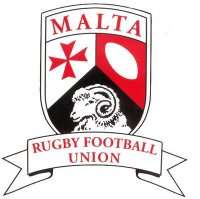Rugby union in Malta
| Rugby union in Malta | |
|---|---|
 | |
| Country | Malta |
| Governing body | Malta Rugby Football Union |
| National team | Malta |
| First played | Late 19th century |
| Registered players | 4575 |
| Clubs | 12 |
National competitions | |
Rugby union in Malta is a small but growing sport. The national senior men's team are currently (March 2015) ranked 40th by the IRB.[1] The national senior men's team are currently (March 2015) ranked 40th by the IRB.[2] This is the islands highest international rank.
Governing body
The governing body is the Malta Rugby Football Union.[3] Since 2000, the MRFU has been a full member of the IRB.[4]
History
Rugby was first brought into Malta by the British, who ruled the island for nearly 200 years. The first matches appear to have been played by British sailors during the late 19th century.
In 1946, the Overseas Rugby Club was established, becoming the first proper rugby club on the island, which consisted mainly of British servicemen.[4]
However, the game only started becoming properly organised at the end of the 20th century. During the 1970s, St. Edwards College and Tal-Handaq College started teaching the game, but it also received a blow, in 1979, with the withdrawal of Malta from NATO, which deprived it of the military teams which had formerly played there.[4]
In 1991, the University Rugby Football Club (now Alligators RFC) was set up, and the Overseas RC revived. Other clubs such as the Kavallieri and Stompers joined them.[4]
In 2006, women's rugby began in Malta, now boasting five active clubs and a strong national 7's program.
In recent years, there has been some competition from rugby league in Malta.
During the 2008 national election, the Nationalist Party, or PN, included the construction of a national rugby stadium as an element in its platform. The PN was victorious in the 2008 election, and formed government. In 2010, it announced the beginning of the fulfillment of this promise through a plan for the construction of such a stadium, connected to a larger sporting, recreational and residential complex[5] with at least one rugby pitch beyond that of the stadium.
Due to its mild Mediterranean climate, Malta is a popular destination for rugby tours.
Domestic Competitions
As of the 2009-2010 season (the Maltese domestic rugby season traditionally runs through the Northern Hemisphere winter), there were four primary domestic competitions for senior men, two for senior women, and three age-grade competitions for junior boys.[6]
Senior Men:
- Cisk Lager Men's Championship (8 matches per team, 15-aside)
- MRFU Cup (4 matches per team, 15-aside)
- MRFU 10s League (8 matches per team, 10-aside)
- MRFU 10s Cup (3 matches per team, 10-aside)
The 10-aside competitions function as "second division" competitions, consisting largely of clubs' second teams and teams from smaller clubs.
Senior Women:
- MRFU 10s Cup (3 matches per team, 10-aside)
- Ben Bennett 7s Cup (9 matches per team, 7-aside)
Junior Boys:
- U17s GasanMamo Youth League
- U15s GasanMamo Youth League
- U13s GasanMamo Youth League
Clubs
There are seven active (entered at least one of the national competitions in 2009-10) clubs in Malta,[6] as follows:
- Birkirkara Alligators (All competitions except the Senior Men's 10-aside Cup)
- Falcons (All Senior men's & Women's & Junior Boys' competitions)
- Kavallieri (All competitions except the U13 Boys' League)
- Swieqi Overseas (Senior Men's 15-aside)
- Qormi Wasps (Senior Men's 10-aside)
- Sliema Stompers RFC (All Senior Men's and Women's competitions)
- Valletta Lions (All Senior Men's & Women's competitions)
National teams
The Malta national rugby union team (men's) competes in the European Nations Cup (ENC). They have done well, when compared to the size and playing population of the country. They completed the 2008-2010 competition in Division 2B of the ENC. They finished 3rd in the two-year competition, meaning that they are playing in the same division (renamed "2A") for the 2010-2012 competition. A number of players come from the Maltese diaspora in the UK and Australia. However, the number of locally based players is increasing.
The Maltese national women's rugby 7's team have been very successful in European competitions, earning promotion in 2009 to the "A" division of these tournaments (the middle of three European divisions).
Women's rugby
Although Malta's women have not yet played test match rugby, they have been playing international sevens rugby since 2004. (Current playing record).
References
- Richards, Huw A Game for Hooligans: The History of Rugby Union (Mainstream Publishing, Edinburgh, 2007, ISBN 978-1-84596-255-5)
- ↑ IRB.com retrieved 27 June 2010
- ↑ IRB.com retrieved 27 June 2010
- ↑ http://www.maltarugby.com/page.asp?n=newsdetails&i=13064
- 1 2 3 4 http://www.maltarugby.com/page.asp?p=14400&l=1
- ↑ http://www.irb.com/newsmedia/regional/newsid=2039375.html
- 1 2 http://www.maltarugby.com/page.asp?p=19932&l=1
External links
- IRB page
- official union page
- FIRA-AER Malta page
- Malta Rugby News
- Malta Rugby Tours
- Malta Rugby 7s
- (French) Archives du Rugby: Malte